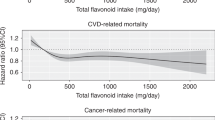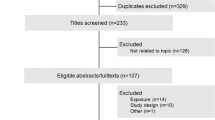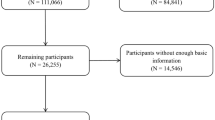Abstract
Thearubigins (TR) are polymeric flavanol-derived compounds formed during the fermentation of tea leaves. Comprising ∼70% of total polyphenols in black tea, TR may contribute majorly to its beneficial effects on health. To date, there is no appropriate food composition data on TR, although several studies have used data from the US Department of Agriculture (USDA) database to estimate TR intakes. We aimed to estimate dietary TR in the European Prospective Investigation into Cancer and Nutrition (EPIC) cohort and assess the impact of including TR or not in the calculation of the total dietary flavonoid intake. Dietary data were collected using a single standardized 24-h dietary recall interviewer-administered to 36 037 subjects aged 35–74 years. TR intakes were calculated using the USDA database. TR intakes ranged from 0.9 mg/day in men from Navarra and San Sebastian in Spain to 532.5 mg/day in men from UK general population. TR contributed <5% to the total flavonoid intake in Greece, Spain and Italy, whereas in the UK general population, TR comprised 48% of the total flavonoids. High heterogeneity in TR intake across the EPIC countries was observed. This study shows that total flavonoid intake may be greatly influenced by TR, particularly in high black tea-consuming countries. Further research on identification and quantification of TR is needed to get more accurate dietary TR estimations.
This is a preview of subscription content, access via your institution
Access options
Subscribe to this journal
Receive 12 print issues and online access
$259.00 per year
only $21.58 per issue
Buy this article
- Purchase on Springer Link
- Instant access to full article PDF
Prices may be subject to local taxes which are calculated during checkout

Similar content being viewed by others
References
Arab L, Liu W, Elashoff D . Green and black tea consumption and risk of stroke: a meta-analysis. Stroke 2009; 40: 1786–1792.
Gardner EJ, Ruxton CH, Leeds AR . Black tea—helpful or harmful? A review of the evidence. Eur J Clin Nutr 2007; 61: 3–18.
Yuan JM, Sun C, Butler LM . Tea and cancer prevention: epidemiological studies. Pharmacol Res 2011; 64: 123–135.
US Departament of Agriculture. USDA Database for the Flavonoid Content of Selected Foods. USDA: Beltsville, MD, USA, 2007.
Kuhnert N . Unraveling the structure of the black tea thearubigins. Arch Biochem Biophys 2010; 501: 37–51.
Santos-Buega C, Scalbert A . Proanthocyanidins and tannin-like compounds—nature, occurrence, dietary intake and effects on nutrition health. J Sci Food Agric 2000; 80: 1094–1117.
Kuhnert N, Drynan JW, Obuchowicz J, Clifford MN, Witt M . Mass spectrometric characterization of black tea thearubigins leading to an oxidative cascade hypothesis for thearubigin formation. Rapid Commun Mass Spectrom 2010; 24: 3387–3404.
Menet MC, Sang S, Yang CS, Ho CT, Rosen RT . Analysis of theaflavins and thearubigins from black tea extract by MALDI-TOF mass spectrometry. J Agric Food Chem 2004; 52: 2455–2461.
Lakenbrink C, Lapczynski S, Maiwald B, Engelhardt UH . Flavonoids and other polyphenols in consumer brews of tea and other caffeinated beverages. J Agric Food Chem 2000; 48: 2848–2852.
Chun OK, Chung SJ, Song WO . Estimated dietary flavonoid intake and major food sources of US adults. J Nutr 2007; 137: 1244–1252.
Zamora-Ros R, Andres-Lacueva C, Lamuela-Raventos RM, Berenguer T, Jakszyn P, Barricarte A et al. Estimation of dietary sources and flavonoid intake in a Spanish adult population (EPIC-Spain). J Am Diet Assoc 2010; 110: 390–398.
Johannot L, Somerset SM . Age-related variations in flavonoid intake and sources in the Australian population. Public Health Nutr 2006; 9: 1045–1054.
Zamora-Ros R, Knaze V, Luján-Barroso L, Romieu I, Scalbert A, Slimani N et al. Differences in dietary intakes, food sources, and determinants of total flavonoids between Mediterranean and non-Mediterranean countries participating in the European Prospective Investigation into Cancer and Nutrition (EPIC) study. Br J Nutr 2013; 109: 1498–1507.
Slimani N, Kaaks R, Ferrari P, Casagrande C, Clavel-Chapelon F, Lotze G et al. European Prospective Investigation into Cancer and Nutrition (EPIC) calibration study: rationale, design and population characteristics. Public Health Nutr 2002; 5: 1125–1145.
Slimani N, Ferrari P, Ocké M, Welch A, Boeing H, Liere M et al. Standardization of the 24-hour diet recall calibration method used in the european prospective investigation into cancer and nutrition (EPIC): general concepts and preliminary results. Eur J Clin Nutr 2000; 54: 900–917.
Slimani N, Deharveng G, Charrondière RU, van Kappel AL, Ocké MC, Welch A et al. Structure of the standardized computerized 24-h diet recall interview used as reference method in the 22 centers participating in the EPIC project. European Prospective Investigation into Cancer and Nutrition. Comput Methods Programs Biomed 1999; 58: 251–266.
Guo Z, Chen Q, Chen L, Huang W, Zhang C, Zhao C . Optimization of informative spectral variables for the quantification of EGCG in green tea using Fourier transform near-infrared (FT-NIR) spectroscopy and multivariate calibration. Appl Spectrosc 2011; 65: 1062–1067.
Fujihara T, Nakagawa-Izumi A, Ozawa T, Numata O . High-molecular-weight polyphenols from oolong tea and black tea: purification, some properties, and role in increasing mitochondrial membrane potential. Biosci Biotechnol Biochem 2007; 71: 711–719.
Acknowledgements
This work was carried out with the financial support of the European Commission: Public Health and Consumer Protection Directorate 1993–2004; Research Directorate-General 2005; French League against Cancer, Institut National de la Santé et de la Recherche Médicale(INSERM), Mutuelle Générale de l’Education Nationale, Institut Gustave Roussy (France); German Cancer Aid; German Cancer Research Center; German Federal Ministry of Education and Research; Danish Cancer Society; the Spanish Ministry of Health (ISCIII RETICC RD06/0020/0091); Spanish Regional Governments of Andalusia, Asturias, Basque Country, Murcia (No 6236) and Navarra and the Catalan Institute of Oncology; Cancer Research UK and the Medical Research Council (United Kingdom); the Stroke Association, UK; British Heart Foundation; Department of Health, UK; Food Standards Agency, UK; the Wellcome Trust, UK; the Hellenic Health Foundation and the Stavros Niarchos Foundation; Italian Association for Research on Cancer; Compagnia San Paolo, Italy; Dutch Ministry of Public Health, Welfare and Sports; Dutch Ministry of Health; Dutch Prevention Funds; LK Research Funds; Dutch ZON (Zorg Onderzoek Nederland); World Cancer Research Fund (WCRF); Statistics Netherlands (The Netherlands); Swedish Cancer Society; Swedish Scientific Council; Regional Government of Skane, Sweden; Nordforsk—Center of Excellence programme; Some authors are partners of ECNIS, a network of excellence of the 6FP of the EC. RZR is thankful for a postdoctoral ‘Sara Borrell’ program (CD09/00133) from the MEC and the Instituto de Salud Carlos III. We also thank Raul M García for developing an application to link the FCDB and the 24-HDR.
Author information
Authors and Affiliations
Corresponding author
Ethics declarations
Competing interests
The authors declare no conflict of interest.
Additional information
Contributors: RZ-R and CAG designed the research; RZ-R and VK conducted the research; RZ-R performed the statistical analysis; RZ-R wrote the manuscript; all authors read, critically reviewed and approved the final manuscript.
Rights and permissions
About this article
Cite this article
Zamora-Ros, R., Knaze, V., Romieu, I. et al. Impact of thearubigins on the estimation of total dietary flavonoids in the European Prospective Investigation into Cancer and Nutrition (EPIC) study. Eur J Clin Nutr 67, 779–782 (2013). https://doi.org/10.1038/ejcn.2013.89
Received:
Revised:
Accepted:
Published:
Issue Date:
DOI: https://doi.org/10.1038/ejcn.2013.89
Keywords
This article is cited by
-
Descriptive analysis of dietary (poly)phenol intake in the subcohort MAX from DCH-NG: “Diet, Cancer and Health—Next Generations cohort”
European Journal of Nutrition (2023)
-
Flavonoids are promising safe therapy against COVID-19
Phytochemistry Reviews (2022)
-
Estimated dietary intake of polyphenols in European adolescents: the HELENA study
European Journal of Nutrition (2019)
-
Dietary intake of 20 polyphenol subclasses in a cohort of UK women
European Journal of Nutrition (2016)
-
Dietary polyphenol intake in Europe: the European Prospective Investigation into Cancer and Nutrition (EPIC) study
European Journal of Nutrition (2016)



